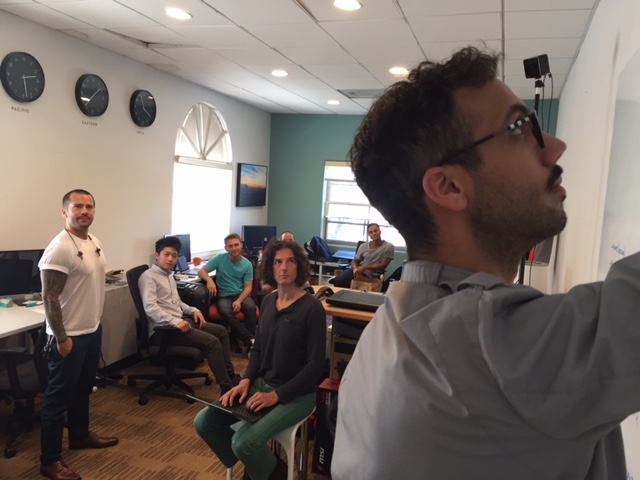The AfterNow team meets for a weekly Tactical meeting.
It's been almost a year since our last article on Holacracy. Looking back as our facilitator, I can see where we were, our lessons learned, and how the changes we have made have improved our governing. I can also look forward to things yet to come.
Last time, we were struggling with purpose and domain. We took care of that -- now we are struggling with other, more fine-tuned things, like how we want roles to look, the length and specificity of roles, and intelligent design vs. natural evolution of role design.
Here's a countdown of five major lessons we've learned over the past year and a half:
5. There can always be more clarity, but it's fine for now.
Now this took my completest, OCD self some time to accept, but once I did it made the process smoother for the person holding a tension and trying to resolve it. There were times when the tension-holder would incorrectly format the tension, and I had to learn to accept it. We would still fix some small things, like making each accountability start with an action verb that reflected ongoing actions (think words ending in -ing: creating, developing, organizing, etc), but sometimes the overall themes didn't 100% match. I had to learn to let that go - we can always change it later.
Other times, the accountabilities weren't crystal clear, but they made sense to the tension-holder and they felt it would solve their tension; again, if it works for them, that has to be enough for me, the facilitator.
4. Make a clear decision about what will and won't be in Holacracy early on.
Now this was a lesson I wish I'd learned earlier. We had lived for so long with the assumption that everything was under Holacracy that when someone would have a sticky tension about pay or time off or how to fire someone, it was hard to keep the peace and find an avenue for processing that tension. Some of these tensions didnt even cleanly fit into the system -- especially when changing something might put you out of compliance with your state's labor laws or the government's financial requirements. This would lead to stalemates and half-solutions.
We finally had a meeting at the whiteboard and made two lists: "In Holacracy" and "Out of Holacracy." We had a conversation and placed items on either list. We then decided that everything not explicitly on the out "Out" list would be considered to be on the "In" list in case something comes up in the future. Then we gave the lead link power to remove things from Holacracy if they felt it appropriate.
3. Pre-write your tensions and solutions.
Having 10 people sit in a four-hour meeting where they have little involvement is expensive and wasteful, and that would happen all the time when someone had a tension but couldn't really figure out how to say it or how they wanted to fix it. For the sake of everyone's sanity, we no longer allow that. Tension-holders now have to come with the tension and solution written down on a Google doc, which we project in the meeting. We still let the holder have a discussion or ask for advice if they need it, but this just speeds up all the early work for us and saves hours of time.
If you didn't do that we acknowledge that you have a tension, write it down, and tell you to do your homework for the next Governance. We are all busy people.
2. Stop being such an activist.
Or what I call an "activist facilitator." This means stopping the process to suggest solutions to tension-holders, butting in on conversations, and interjecting my own thoughts.
Being the person that I am, I tend to want to exert too much control over things (a designers curse, perhaps?) and that's not always great, especially when I don't really have the right. The facilitator role only cares about maintaining the process and making space for others to participate. I was taking that too far -- I even tried to change the role (HUGE no-no).
This was the lesson learned for me personally: Guard the process and create an environment of welcome. This will let others participate and will involve them more in the process of Holacracy, which is a good thing.
1. Governance is more about creating than destroying.
In the past year, I think this is the most important and broadest lesson we have learned. We've had conversations and sessions centered on whether we should have roles that have more accountabilities in them or less. I'm of the mindset to make roles smaller, but others like them bigger.
We have found that whenever we are even a little upset about something, it usually stems from not being wholly integrated into Holacracy - even 18 months later, we still have new roles to make and work that is getting clarified and brought into the fold. We thought we had all that figured out a year ago, but as we continue to learn, this is an ongoing process.


